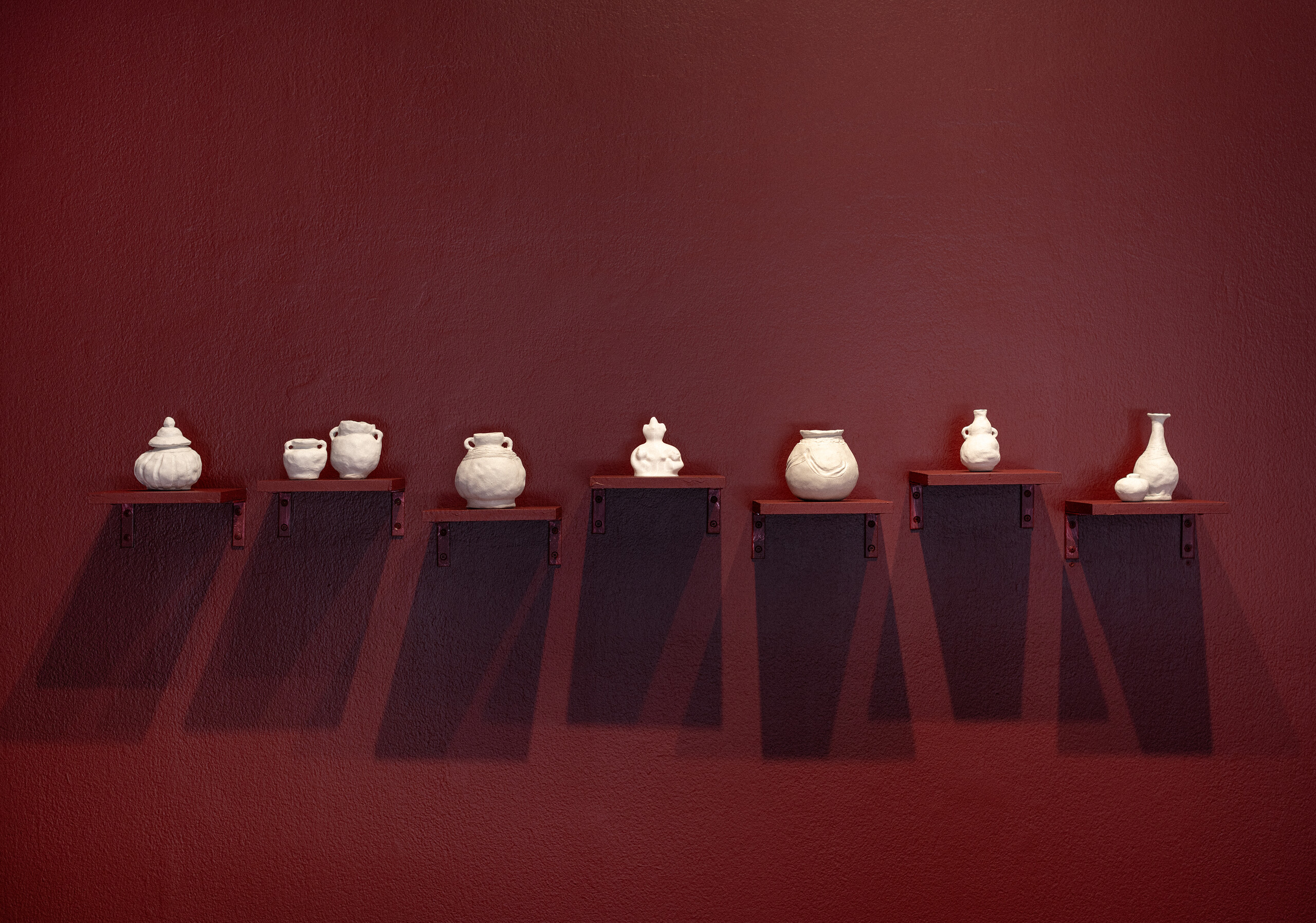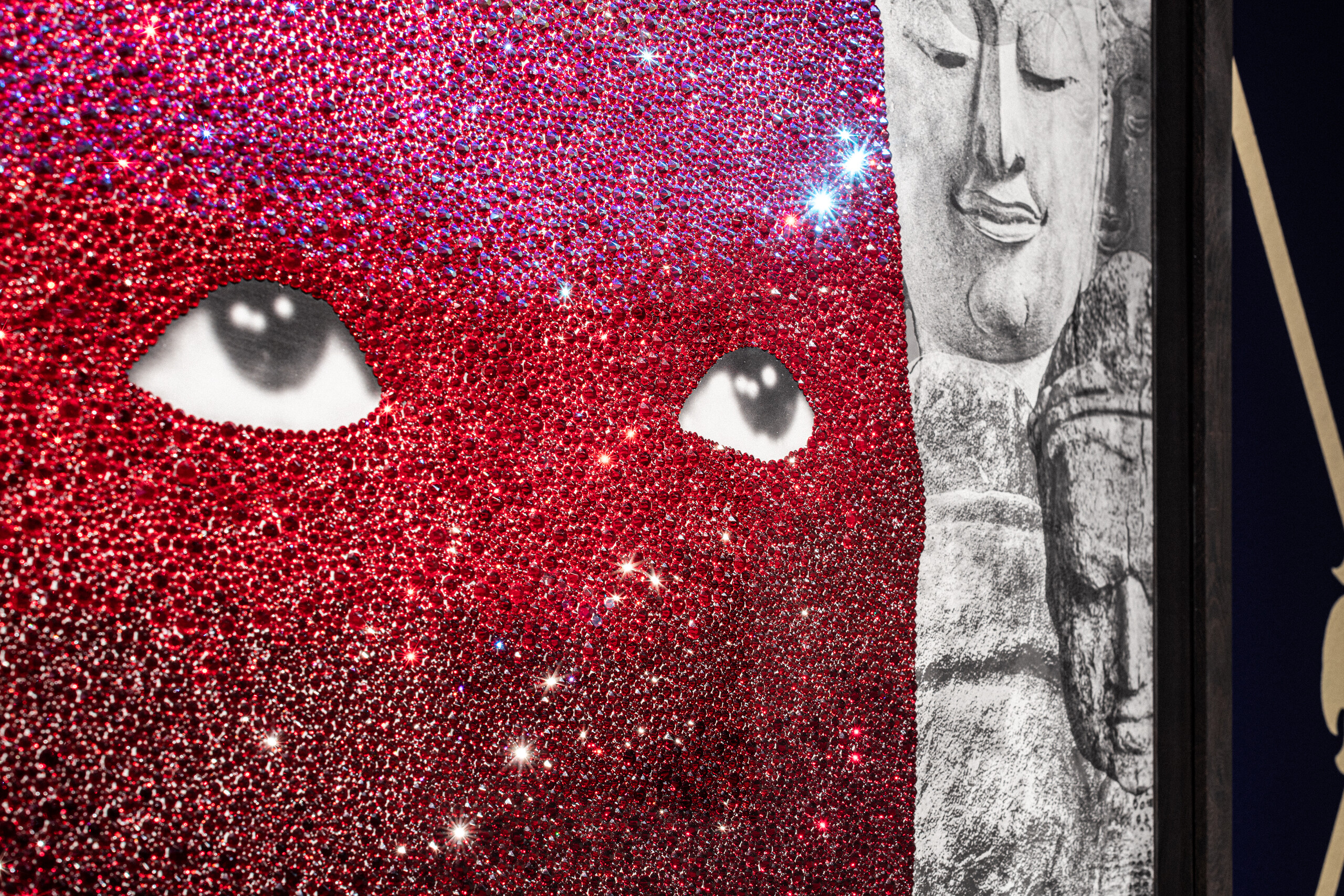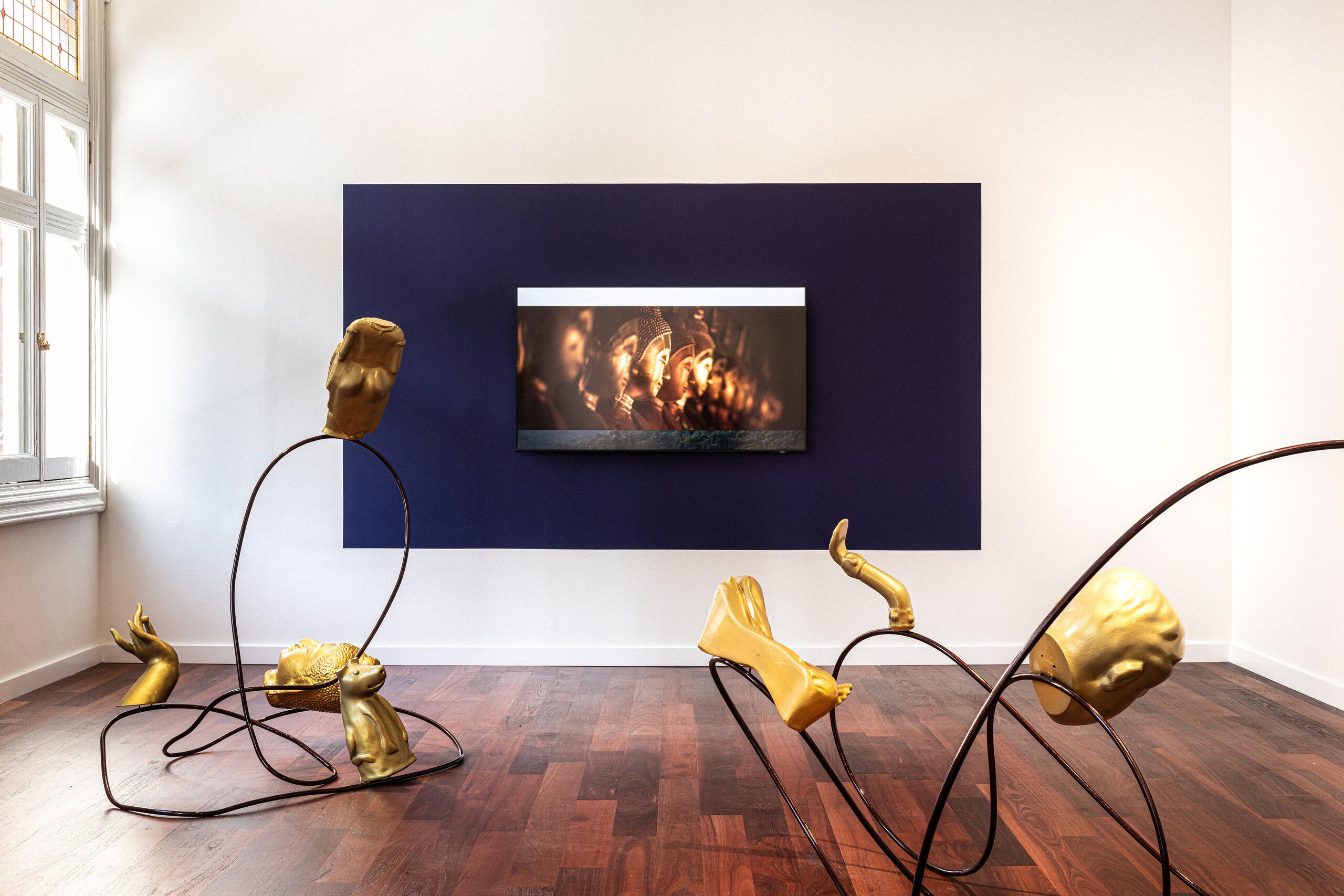A Puzzlement
Jennifer Yang
For those yet to pay A Puzzlement a visit, consider going in the evening. Against the quieter, dark tones of a warm Thursday night in Haymarket, Nathan Beard’s transformation of the first floor of Sydney’s 4A Centre for Contemporary Art glows: the dramatic effects of the show’s lighting design recall the austerity of a museum hang, and the walls pulse in a sumptuous red—British Paint’s “Indian Red,” to be exact. This detail is important, as we will come to realise.
In bringing The Puzzlement to Sydney after its first two iterations in London and Perth, Nathan Beard has greeted the city by staging an imaginary museum of artefacts of Thai provenance, reproduced from the collections of Powerhouse Museum, The Art Gallery of New South Wales, and the Chau Chak Wing Museum. 4A has kept this new body of work at street level, just a short walk from the Thai Town shopfronts along Campbell Street, while reserving the upper floor of the gallery for works made by Beard during a residency in London and shown at PICA last year. Encompassing sculpture, print, photography, and video, the exhibition presents a cross-section of the artist’s oeuvre, which straddles the bounds between art-making and archival research.

There seems to be much contemporary interest in revisiting the archive—a “compulsive, repetitive and nostalgic desire” or “archive fever” as Jacques Derrida diagnosed. But in theorising the archive, one cannot ignore the violence it enacts (I am reminded of Saidiya Hartman’s likening of the archive to a mortuary as she parses the violence of erasure in colonial archives). The institutional archive displays death but can also sentence it. Removed from the rubric of its original context and environs, an object entering an archive or collection is often one reaching its final destination. Beard catches on and seems to pose a response: If the archive is where an object goes to die (or rest), what better way to re-animate it than by 3D scanning and reconstructing it to incredible precision?
Hovering against 4A’s red-painted walls, Beard’s reproduced artefacts appear spectral. Each one is a ghostly form of the original: the plastic is flawless white with a fibrous sheen, as if spun in gossamer, and the unblemished surface couples bizarrely with the original artefact’s contours and depreciations. This insistent perfection lapses momentarily in Beard’s presentation of imitation earthenware, moulded by hand from air-dry clay. It is a nod to the artist’s faithful attention to materiality, and although it does not quite match the scope of the material explorations upstairs, it reminds us of the touch of the artist’s hand. And indeed, there is more being done here than the simple resuscitation or re-presentation of museum objects. Reading the archive is often just as much about production as it is about retrieval. Beard’s recasting of once precious artefacts shifts our way of relating to them—the objects now seem to slip along a continuum toward becoming shiny, shoppable commodities.

This playfulness is joined with criticality. If anything appears out of place, it is probably because the objects are not installed at the standard (read: 180 cm tall man) sightline of 150 cm. Instead, they have been lowered by 10 cm to the eyelevel of a Thai woman of average height. It is a strategic decision. The blurred boundaries between high and low art, artifice and authenticity, commodity and priceless relic in Beard’s art-making are well served by the far-reaching parameters of his control over the exhibition, as he recruits each element of the viewing experience into artistic play.
The lowering is a kind of disobedience, a slight against the rigid conventions of exhibition design. The lowering precipitates questions: Who is a museum made for? Who is invited to gaze? Whose gaze is assumed and accommodated? What is being gazed upon? We talk often about the value of cultural institutions like museums—one of the few remaining non-commercial public spaces in our age of consumption and hyper-productivity. But, to see the museum as a freely accessible safehaven is to conveniently forget the institution’s colonial history, its often-hostile infrastructures of knowledge and physical architecture. These are questions which implicate the lives—or deaths—of artefacts in the collections of Western institutions. In the name of conservation, objects become subject to the scrutinising eyes of a foreign audience and to practices of museological care, fixed into place by a decreed responsibility to care for objects and preserve institutional legacies. Beard’s reproduced museum, in its deviance and disobedience, reminds us of the hegemonies of seeing which triangulate the space of the cultural institution.
The lowering is also a sweet thing, a gift for Beard’s late mother. The artist had originally requested for works to be displayed for her eye-line. I smile to think that my grandmother (only 148 cm tall) would also very much like this idea. And I wonder if intervention must always be expressed in an idiom of outrage, total dismantlement, and a tearing down of structures—can it perhaps be paraphrased in forms and acts of tenderness and repair? In speculating about the reconstitution/repatriation of these (ghost-)objects, can we imagine and articulate these efforts in positive terms of gain and generative possibility rather than loss?
These contemplations become more fully formed upstairs. The same approach to archival research plays out here, this time from the collections of The British Museum, Victoria & Albert Museum, British Film Institute and Kew Gardens. Spanning a dizzying range of materials and media, the works are spectacular, but somehow avoid suggestions of a distracted or inchoate art practice. Rather, there is something very fastidious about Beard’s way of working. No element or work seems to stand alone. But some things catch my eyes first.

There is no denying the absolute visual splendour of Beard’s Swarovski crystal-studded photographic prints. In the evening, 4A’s space is unimpaired by the sunlight which usually free flows through its windows, and in the dim light, the prints glitter lavishly. Indeed, so brilliant is their shimmer that they risk losing the viewer in their scintillation. I am curious to know how many people wander through the space and indulge in the spectacle of it all without ever broaching what lies beneath the crystal-crusted and varnished surfaces. It is a kind of optic entrapment, mirage-like obfuscation, deflective, refractive—and perhaps also protective—never truly letting the viewer take in and know the subject fully. The crystals flatten the features of each portrait, leaving only the eyes and the mouths, which are cut out and glued to the surface of the frame’s acrylic sheet.

There is a reference here to the utopian conjurations of a 1980s tourism campaign slogan—Thailand as the “Land of Smiles”—which lingers in the global imagining of Thailand, and in the subject headings of countless online travel blogs. The smile as signifier of the Thai national character has also been entertained in one of the country’s first and most formative contemporary art exhibitions. In September 2008, Traces of Siamese Smile: Art + Faith + Politics + Love opened as a mega-show in commemoration of the newly developed Bangkok Arts and Cultural Centre (BACC), curated by a team of art professionals led by Thai art historian, critic, and curator Apinan Poshyananda, and gathering together a sprawling selection of over three hundred works. But whereas the curatorial framing of Traces of Siamese Smile was loosened by a broader agenda of constructing a summative account of Thai art history, the smiles on show in A Puzzlement cocoon around the fallacy of an authentic Thai visuality. The images in Beard’s Swarovski-studded prints are film production stills of King Mongkut and his wife Lady Thiang, played by European actors Yul Brynner and Terry Saunders in the film The King and I (1956), a film banned in Thailand for its offensive caricature of Thai culture. The rightmost portrait is a picture of a young Prince Chulalongkorn, King Mongkut’s son, taken by a Scottish travel photographer. Altogether they comprise a disjointed royal family portrait, inseparable from foreign constructions of Thai culture, the gaze of the outsider.

On the wall perpendicular is a portrait of botanist A.F.G. Kerr. This might appear out of place if one were not familiar with Beard’s extended exploration of orchids and botanical science in the construction of an exotic vision of Thailand. But there is a fruitful analogy to be drawn here between the European fascination for the exotic and rare orchid—the act of plucking the orchid and extracting it from its soil, bringing it to Europe for consumption and collection—and the broader procedures of colonial conquest. Beard maps Thailand—a country which was never colonised—in relation to the overlapping histories and territories of colonial empires in the region. The wallpaper—a gold lattice pattern referencing a wall painting of a shrine in Nakhon Nayok, Beard’s mother’s hometown—hints at a history of British colonial encroachment, with its decorative motifs overlaying an indigo blue paint trademarked as “Thai Sapphire” by British paint manufacturer, The Little Greene, as part of their Colours of England Collection.
The close attention paid to the names of paint shades is suggestive of another axis of critique embedded in Beard’s works. Beard collects and layers an assortment of colours of Thailand, as designated by global luxury brands—the Swarovski crystals are coloured in shades which reference the nostalgic exonym, Siam, and Gucci’s 2014 nail varnish in Siam Red, painted onto Beard’s twisting sculptural pieces, once again invokes through its titling a glorious, mythic past. Constructs of Thai-ness cannot be extricated from the sellable visions of Thailand generated by a hierarchised global market of capital production and consumption. Likewise, the sculptures—conceived as the physical form of the dust clouds of comic strip scuffles from which random objects and limbs protrude—play on the hollowness of these surface signifiers. The gold exteriors of the objects—an assortment of shrine statues collected by his mother, mass-produced figurines, kitschy Thai-themed toys, and museum artefacts blown up to roughly standardised proportions—contrast with their weightlessness, welded onto thin rods and flung into the air. The sculptural fight cloud is an equaliser; there are no hierarchies of taste or cultural authenticity in the ambiguous encounter/clash/dance of these objects.

This ambitious collection of works is knitted together (sonically, visually, and thematically) by the video work A Puzzlement which plays at the other end of the room. Composed by Mei Saraswati, the score—like the exhibition title—references The King and I, stitching its sweeping orchestral fanfare together with the sounds of piphat, which then blur into the jejune melodies of Disney’s “Siamese Cat Song” from The Lady and The Tramp. Every now and then, the synth hook of international K-pop girl group BlackPink’s hit single Ddu-Du Ddu-Du wafts through the space, forming a strangely haunting cadence when isolated from its upbeat pop chorus. In moving images, Beard once more works through what he has described as a methodology of autoethnography—a privileging of the artist’s own experiences and encounters amidst a playful collection of sources spanning across time and space, and across the realms of popular culture, institutional archives, official history, and personal memory. Beard’s own footage of the mountain vistas of Nakhon Nayok is the supporting matrix for an interplay of found photographs, excerpts from foreign documentary films and contemporary Hollywood productions set in Thailand, and footage filmed with a Super 8 mm camera by Beard’s family on vacation trips. In the video, the seams of Beard’s patchwork are revealed in the still-visible frames and grainy resolution of found footage, in the misalignment of horizon lines spliced over one another. The full weight and thoroughness of Beard’s artmaking/archival process—already intimated in the labour-intensive production of his works—is stretched across time and visualised here. Doubling as both an overture and coda to the themes of the exhibition, A Puzzlement offers no answer to our fervent efforts to approach an image of Thai-ness, to decode and unpack each sign and symbol and reference that Beard builds into his artistic bricolages. Malleable, tongue-in-cheek, and never quite containable within our horizon of knowledge, A Puzzlement is an exhibition as slippery in its assortment of material forms as it is in its reflections of a vision of Thai culture. For this, it is one worth observing.
Jennifer Yang is a writer from Gadigal/Sydney. She will begin her PhD candidature at the University of Sydney in 2024 and is interested in exploring ties between photographic visuality, gender and transnational mobility in Southeast Asian contexts.


